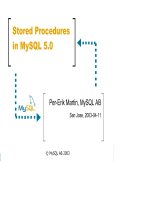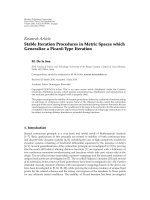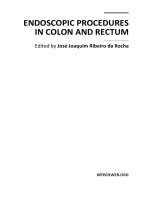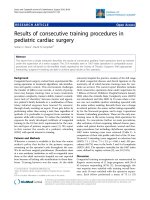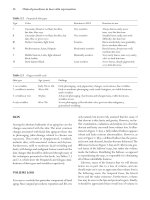Procedures in early-mid-pregnancy
Bạn đang xem bản rút gọn của tài liệu. Xem và tải ngay bản đầy đủ của tài liệu tại đây (77.05 KB, 11 trang )
Section 2 – Pregnancy
I Procedures in early/mid-pregnancy
4 CERVICAL SUTURE (CERCLAGE)
Cervical suture (Shirodkar or McDonald cerclage) is performed to reduce the
incidence of spontaneous miscarriage when there is cervical incompetence.
Although it can be done before conception or as an emergency during pregnancy,
the procedure is usually performed electively at 12–16 weeks’ gestation; it generally
takes 10–20 minutes and is performed transvaginally on a day-case basis. A non-
absorbable stitch or tape is sutured in a purse-string around the cervical neck at the
level of the internal os; this requires anaesthesia since the procedure is at best
uncomfortable, although the suture can usually be removed easily without undue
discomfort (usually at 37–38 weeks’ gestation unless in preterm labour); spontane-
ous labour usually soon follows.
In patients with a grossly disrupted cervix, e.g. following surgery, placement
of the suture via an abdominal approach may be required. Delivery is usually
by elective Caesarean section in these cases.
Problems/special considerations
Women undergoing cervical suturing may be especially anxious since previous
pregnancies have ended in miscarriage. Otherwise anaesthesia is along standard
lines, bearing in mind the risks of anaesthesia in the pregnant woman and monitor-
ing of, and possible effects of drugs on, the fetus (see Chapter 7, Incidental surgery
in the pregnant patient, p. 12).
Cerclage may be difficult if the membranes are bulging; the head-down position
and/or tocolysis may be requested to counter this.
Management options
Many authorities advocate spinal anaesthesia as the technique of choice since
only a small amount of a single drug is administered, although epidural anaesthesia
is also acceptable. If spinal or epidural anaesthesia is chosen, standard techniques
are used. The procedure itself requires a less extensive block than Caesarean section
Analgesia, Anaesthesia and Pregnancy: A Practical Guide Second Edition, ed. Steve Yentis, Anne
May and Surbhi Malhotra. Published by Cambridge University Press. ß Cambridge University
Press 2007.
(from T8–10 down to and including the sacral roots) and thus smaller doses are
required; however, the reduction is offset by the greater requirements at this early
stage of pregnancy compared with the term parturient. Thus the doses required for
regional anaesthesia are in the order of 75% of those used for Caesarean section.
Low-dose techniques have also been used, as for Caesarean section; the women
have more sensation (though painless) but have less motor block.
General anaesthesia may also be used; an advantage is the relaxing effect of
volatile agents on the uterus, but it does usually involve administration of more
than one drug, and the effects on the fetus of many agents in current use are not
clear. There may also be an increased risk of regurgitation and aspiration of gastric
contents, depending on the gestation and severity of symptoms (see Chapter 56,
Aspiration of gastric contents; p. 138).
Paracervical and pudendal block and/or intravenous analgesia/sedation
may also be used, but most authorities would recommend avoiding paracervical
block because of the potential adverse effects on uteroplacental perfusion.
Key points
• Cervical suture is usually performed at 12–16 weeks’ gestation.
• Patients may be especially anxious because of previous miscarriage.
• Standard techniques are used; spinal anaesthesia may be preferable.
FURTHER READING
Drakeley AJ, Roberts D, Alfirevic Z. Cervical stitch (cerclage) for preventing pregnancy
loss in women (Cochrane Review). In: The Cochrane Library, Issue 4, 2003. Chichester,
UK: John Wiley & Sons, Ltd.
5 ECTOPIC PREGNANCY
There are approximately 11 000 ectopic pregnancies per year in the UK (just over
1% of all pregnancies), and the incidence is thought to be increasing as a result of
pelvic inflammatory disease. There are many risk factors, with tubal pathology or
surgery and use of an intrauterine device the most important; others are infertility,
increased maternal age and smoking. About 3–5 women die as a consequence in the
UK per year, representing about 3–6% of all direct maternal deaths ($1 per 2500
ectopics). Most ectopic pregnancies occur in the Fallopian tube, but up to 5% occur
elsewhere within the genital tract or abdomen. Typically, the tube initially expands
to accommodate the growing zygote but when unable to do so any more, there
may be bleeding from the site of implantation or even rupture of the tube. Thus
the classic presentation is with abdominal pain, which may be sudden in onset,
accompanied by a history of amenorrhoea (although there is vaginal bleeding
8 Section 2 – Pregnancy
at presentation in $80% of cases). There may be sudden collapse if the tube
ruptures, caused by reflex vagal activity or hypovolaemia if bleeding is severe,
or both.
Problems/special considerations
The main risk of ectopic pregnancy is sudden severe haemorrhage, which may be
intra-abdominal and thus concealed until rapid decompensation and collapse
occur. A common theme in deaths associated with ectopic pregnancy is the
failure to consider the diagnosis before collapse. Ectopic pregnancy may present
with non-specific abdominal signs including diarrhoea or constipation, thus mim-
icking other intra-abdominal conditions (e.g. appendicitis), although with serial
measurement of plasma human chorionic gonadotrophin (hCG; doubles every
2–3 days in normal pregnancy) and use of pelvic ultrasonography this should be
unusual. The potential severity of the condition is not always appreciated by other
hospital staff, the patient herself or her relatives. Ectopics outside the Fallopian
tubes are more likely to be associated with massive haemorrhage, with abdominal
pregnancies the most hazardous, especially when the placenta is removed.
Most ectopic pregnancies present early in pregnancy and thus many of the
physiological changes of pregnancy are absent or mild – the patient may even
be unaware that she is pregnant. However, even at this early stage there may be
features of the physiological changes of pregnancy.
The implications for the current and future pregnancies pose a great psycho-
logical stress on the patient and her partner. There may be a previous history
of ectopic pregnancy since its occurrence is itself a risk factor for subsequent
ectopics.
Management options
Initial management is directed at treating and preventing massive haemorrhage;
thus the patient requires at least one large-bore intravenous cannula and careful
observation at least until the diagnosis has been excluded. Similarly, once the
decision to operate has been made it needs to occur as soon as possible, since
the risk of rupture is always present.
Operative management usually involves laparoscopy unless there is severe
haemodynamic instability, in which case laparotomy is performed. Traditionally,
laparoscopy was performed purely for diagnostic purposes, but laparoscopic
removal of the zygote with or without tubal resection has become routine in
many units. Anaesthetic aspects of the procedure itself are as for any laparoscopic
operation.
Anaesthetic management is as for any emergency surgery, given the above
considerations. Haematological assistance and admission to the intensive care
unit should be available if required. In severe cases, anaesthesia must proceed
as for a ruptured aortic aneurysm: full preoperative resuscitation may be
5 Ectopic pregnancy 9
impossible and the patient is prepared and draped before induction of anaesthesia,
which may be followed by profound hypotension.
In some countries, medical management is increasingly used as the first-
line treatment of early ectopic pregnancies, with intramuscular methotrexate.
The drug antagonises folic acid and prevents further growth of the trophoblast,
which is especially vulnerable at this early stage. Similar outcome to that following
surgical management has been claimed. Local injection of hyperosmolar glucose,
prostaglandin and potassium chloride have also been used. Finally, expectant
management has been used in selected patients, although women whose pregnan-
cies are self-limiting cannot yet be identified reliably.
Key points
• Ectopic pregnancy accounts for 3–6% of all direct maternal deaths in the UK.
• Severe haemorrhage and/or cardiovascular collapse is always a risk.
FURTHER READING
Pisarska MD, Carson SA, Buster JE. Ectopic pregnancy. Lancet 1998; 351: 1115–20.
Tay JI, Moore J, Walker JJ. Ectopic pregnancy. BMJ 2000; 320: 916–19.
6 EVACUATION OF RETAINED PRODUCTS OF CONCEPTION
Evacuation of retained products of conception (ERPC) may be required at any
stage of pregnancy, but it occurs most commonly in early pregnancy following
incomplete miscarriage or early fetal demise. It is also required during the puerpe-
rium following retention of placental tissue (see Chapter 41, Removal of retained
placenta, p. 107).
Problems/special considerations
• ERPC following spontaneous abortion at 8 weeks’ gestation may be a minor rou-
tine gynaecological emergency for the anaesthetist, but the mother may have lost
a much-wanted baby.
• The urgency of the procedure varies greatly. The majority of ERPCs are performed
as scheduled emergencies in fit young women, and this may lull the inexpe-
rienced anaesthetist into a false sense of security. Death may occur
from spontaneous abortion; blood loss may be heavy and is frequently
underestimated.
• The possibility of coexisting uterine or systemic sepsis must always be consid-
ered, especially in postpartum ERPC or in a repeat procedure following
incomplete evacuation.
10 Section 2 – Pregnancy
Management options
• Diagnostic ultrasound scanning is frequently used to confirm a non-viable early
pregnancy or the presence of retained placental tissue. Transabdominal ultraso-
nography is facilitated by a full bladder, which is often achieved by asking the
mother to drink large volumes of water. Most units now operate a policy of fully
assessing mothers on the day of admission in an early pregnancy advisory unit
(EPAU), allowing them home and readmitting them the following day for planned
ERPC. This facilitates planning of medical and nursing staffing levels, reduces
prolonged periods of waiting and starvation for the mother, and can be econom-
ically advantageous.
• Medical treatment is increasingly used and this enables women to be allowed
home, after treatment with prostaglandin analogues, to await events. Some of
these women will need surgical management if the products of conception are
not fully expelled.
• Preoperatively, a full assessment is required. Assessment of blood loss may
be difficult; fit young women may lose a significant proportion of their blood
volume without becoming hypotensive. Tachycardia should alert the anaesthetist
to possible hypovolaemia. Signs of sepsis should be sought, and prophylactic
antibiotics may be considered.
• General anaesthesia is acceptable although in the absence of uncorrected
hypovolaemia or other contraindications, regional anaesthesia is entirely
suitable. The puerperal mother in particular may wish to stay awake if offered
a choice, and she should be advised to do so if at risk of regurgitation.
• Rapid sequence induction of general anaesthesia is indicated for the non-fasting
mother requiring urgent surgery (uncommon) and for the mother who is at risk of
regurgitation (see Chapter 56, Aspiration of gastric contents; p. 138). Anaesthesia
using a laryngeal mask airway or facemask using any standard day-case anaes-
thetic technique is appropriate for the majority of women needing ERPC. Sedative
premedication is rarely needed. Intravenous anaesthesia e.g. with propofol
or inhalational anaesthesia is acceptable, though if the latter is used high
concentrations of volatile anaesthetic agents (41 minimum alveloar concentra-
tion) should be avoided because of the uterine relaxation that may ensue.
• Oxytocic drugs may be requested by the surgeon, although there is little evidence
for their efficacy at gestations of less than 15 weeks. A single intravenous bolus of
5 U Syntocinon usually suffices. Ergometrine causes increased intracranial and
systemic pressure, and nausea and vomiting, and should not be used routinely.
• Spinal anaesthesia produces more rapid and dense anaesthesia than epidural and
an anaesthetic level of at least T8 is recommended. Clinical experience shows that
the traditionally taught anaesthetic level of T10 is insufficient to prevent pain
occurring when the uterine fundus is manipulated or curetted.
• Postoperatively, the aim is rapid recovery and discharge home. Requirement for
postoperative analgesia rarely exceeds simple non-opioid drugs. Non-steroidal
anti-inflammatory agents may be beneficial in relieving uterine cramps.
6 Evacuation of retained products of conception 11


